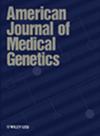Chronic Catatonia in an Individual With a De Novo Missense SHANK1 Variant.
IF 1.7
4区 生物学
Q3 GENETICS & HEREDITY
引用次数: 0
Abstract
SHANK1 encodes a scaffolding protein of the SHANK family that includes SHANK1, SHANK2 and SHANK3. All of the SHANK proteins are enriched at the post-synaptic density of excitatory synapses. Here, we present an 11-year-old boy with a history of developmental delays and no family history of psychiatric disorders who developed catatonia. MRI of his brain and spine were negative as was a workup for autoimmune encephalitis. The proband's genetic testing revealed a de novo heterozygous SHANK1 missense variant. Although catatonia has been reported previously in individuals with SHANK3 loss-of-function mutations, this is the first time catatonia has been described in an individual with a SHANK1 variant.
一名患有新发缺义 SHANK1 变异的患者的慢性紧张症
SHANK1 编码 SHANK 家族的一种支架蛋白,该家族包括 SHANK1、SHANK2 和 SHANK3。所有 SHANK 蛋白都富集于兴奋性突触的突触后密度。在这里,我们要介绍的是一名有发育迟缓病史、无精神病家族史的 11 岁男孩,他患上了紧张性精神分裂症。他的大脑和脊柱核磁共振成像呈阴性,自身免疫性脑炎检查也呈阴性。该病例的基因检测结果显示,他的SHANK1是一个新发杂合型错义变异体。虽然此前曾有报道称患有 SHANK3 功能缺失突变的患者会出现紧张性惊厥,但这是首次描述患有 SHANK1 变异的患者会出现紧张性惊厥。
本文章由计算机程序翻译,如有差异,请以英文原文为准。
求助全文
约1分钟内获得全文
求助全文
来源期刊
CiteScore
3.50
自引率
5.00%
发文量
432
审稿时长
2-4 weeks
期刊介绍:
The American Journal of Medical Genetics - Part A (AJMG) gives you continuous coverage of all biological and medical aspects of genetic disorders and birth defects, as well as in-depth documentation of phenotype analysis within the current context of genotype/phenotype correlations. In addition to Part A , AJMG also publishes two other parts:
Part B: Neuropsychiatric Genetics , covering experimental and clinical investigations of the genetic mechanisms underlying neurologic and psychiatric disorders.
Part C: Seminars in Medical Genetics , guest-edited collections of thematic reviews of topical interest to the readership of AJMG .

 求助内容:
求助内容: 应助结果提醒方式:
应助结果提醒方式:


